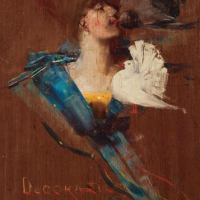59. ARTHUR STREETON

Sir Arthur Streeton (18671943) is widely regarded as one of the early twentieth centurys foremost painters of Australian art. A member of the Heidelberg School that also included Tom Roberts (1856-1931), Frederick McCubbin (1855-1917), and Charles Conder (1868-1909). This celebrated group of painters were once young artists creating rebellious artistic statements in the face of the prevailing academic style. This culminated in their famous 9 by 5 Impression Exhibition of works painted on cigar-box lids staged in Melbourne in 1889, revealing a new aesthetic that reflected international trends of Impressionism. The sketch-like immediacy and freshness that characterised these works caused a sensation, and cemented their place in the story of Australian art.
Soon after the 9 by 5 Impression Exhibition, Conder left for Europe and settled in Paris where he discovered the literature of the French Symbolists which fascinated him. He wrote frequently to Streeton about this new fashion and would decorate his letters with beautiful sketches evoking the ethos and atmosphere of the Chat Noir cabaret in Montmartre.1 The correspondence from Conder was likely to have influenced a group of allegorical paintings produced by Streeton in the mid 1890s. It was around this time that the artist began exploring the Symbolist painting tradition and some of the best examples include Scheherazade 1895 (National Gallery of Victoria collection); Pastoral 1894 (Art Gallery of New South Wales collection); Spirit of the Drought c1895 (National Gallery of Australia collection) and Dolce far Niente (How Sweet to do Nothing) 1894 (present whereabouts unknown).
Streeton found inspiration in the works of British poet and writer Arthur Symons (1865-1945), sculptor Charles Douglas Richardson (1853-1942) and painter Arthur Loureiro (1853-1932), the latter with whom Streeton shared similar narratives. Despite being distanced from the source of Symbolist literature of this time, Streeton enjoyed immersing himself in the writing and poetry coming over from the Continent, recalling how works of great verse are filling my mind with their truth and beauty til I become oblivious to my affairs and the traffic of the busy millions about me.2
The striking composition of Decoration demonstrates the influence of Symbolism on the artist, evident in the side-profile of the female figure and the dominant diagonal line also seen in Streetons Dolce far Niente (How Sweet to do Nothing). The doves may represent the presence of the Holy Spirit, seen here in the act of Holy Communion, placing the bread between the female figures lips, as seen in the early Symbolist work of Dante Gabriel Rossetti (1828-1882), Beata Beatrix c1864-70.The present work, titled simply Decoration, is a rare gem from a relatively small group of paintings within his greater oeuvre.
Footnotes
1. Gott, T., Charles Conder , Arthur Streeton and the Problem Children of Australian Impressionism, in Australian Impressionism, National Gallery of Victoria, Melbourne (exhibition catalogue), 2007, p.245
2. Arthur Streeton, Notes for Memoirs, Australian Impressionism, National Gallery of Victoria, Melbourne (exhibition catalogue), 2007, p.24
Caroline Jones MArtAdmin